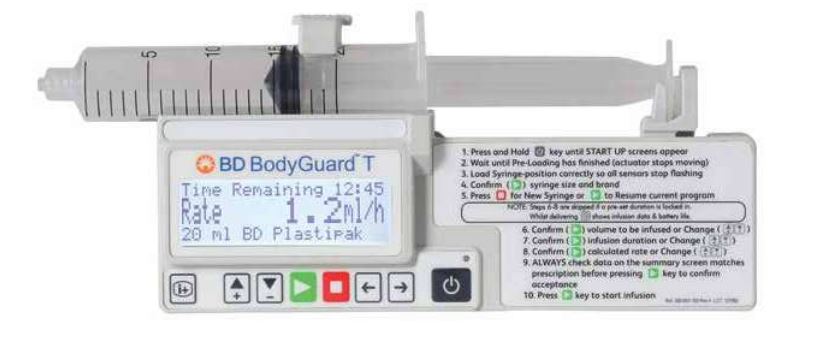Syringe pump
Information for patients and carers from the Supportive and Palliative Care Team
What is a syringe pump?
The syringe pump is a small portable battery operated pump, that pushes a syringe to give you medication slowly over a set period of time, usually 24 hours.

The syringe is connected to the pump and is filled with medicine that has been prescribed by your doctor or nurse to help your symptoms. Your medicine will be reviewed on a regular basis, and may be changed if necessary.
You do not need to do anything to the syringe pump. The medicine will continue to be delivered, usually over 24 hours, continuously helping your symptoms.
Please ask if you have questions about your treatment.
How will the syringe pump be connected to me?
A long thin tube is connected to the syringe, with a tiny needle at the other end. Your doctor or nurse will insert the needle just under your skin, usually in your upper chest area or upper arm. Usually the needle is removed leaving a tiny plastic tube in place. Your doctor or nurse will put a clear dressing over the site to keep it clean, dry, and in place.
Once the needle or tube is in place, you should not feel it and it can stay there for several days.
Why do I need a syringe pump?
Syringe pumps are used for several reasons. It is a simpler and more comfortable way to receive medication for people who would otherwise need repeated injections. Below are some reasons that syringe pumps are used. Not all of these reasons will apply to you.
Some people find it difficult to swallow their medicine in tablet or syrup form.
Some people may feel sick or vomit often, so they cannot keep their medication in their stomach long enough for them to work.
When symptoms are difficult to control by oral medicines alone, a syringe pump may be used until it is possible to restart tablets.
Who will look after my syringe pump?
Your nurses at home, in hospital, or the care home will change your syringe every day and check:
your syringe pump regularly to make sure it is working well
the needle or tube is comfortable, and
there are no problems with the medicines.
How will I know if the syringe pump is working?
If the syringe pump is working normally, a green light next to the on / off button will flash twice a minute. If the pump has stopped for any reason, the light will turn red.
What do I need to look out for?
Your symptoms. Tell your nurse or doctor if your symptoms persist once the syringe pump is set up, or they change in any way.
Your skin. Sometimes the medicine in the syringe can cause a skin reaction. Your nurse will check the needle or tube site regularly. If the area becomes sore, the needle or tube will be moved to another part of your body.
If you notice any of the following, contact your nurse.
The colour of the medicines in the tubing or syringe has changed.
There is a cloudiness or sediment (residue) in the tubing or syringe.
The skin around the needle or tube is red, swollen, or painful.
The alarm on the pump sounds. If this happens, please do not try to remove the syringe or press any of the buttons on the pump, unless told to by your nurse.
What else do I need to look out for?
Syringe pumps are quite strong but they can be damaged if they are dropped or crushed.
A syringe pump must not get wet. Ask your nurse for advice about washing and showering.
Keep the syringe contents out of direct sunlight, and do not allow them to become too hot. Avoid placing the pump next to a heat pad, hot water bottle, or electric blanket. Ask your nurse for advice on the best place to keep your syringe pump.
What do the alarms and alerts mean?
Low or end battery = battery needs changing.
Occlusion = line is kinked or blocked.
Pump paused too long = pump has been stopped for more than two minutes.
End program = the infusion is complete.
Syringe displaced = the syringe has become detached from the driver mechanism.
For all of the alarms above, please call the nursing team.
Syringe nearly empty alert will sound towards the end of the infusion (two beeps every two minutes).
Contact details
If you have any concerns about your care or treatment, please contact: